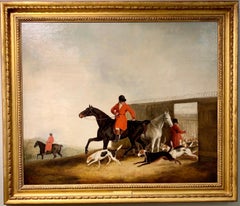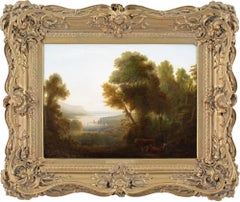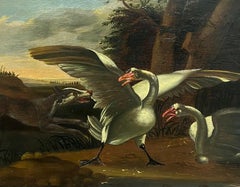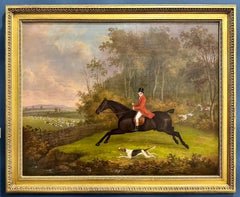1810s Animal Paintings
to
4
4
4
1
2
1
Overall Height
to
Overall Width
to
1
3
3
1
1
1
1
1
1
1
128
799
1,634
5,769
53
33
45
57
65
87
129
106
136
166
82
1
1
4
4
2
2
Period: 1810s
Village Scene Figures & Animals - British Old Master exh pastoral oil painting
By James Ward
Located in London, GB
This stunning British Old Master exhibited pastoral oil on panel is by noted artist James Ward. Painted circa 1815 with superb provenance, it was exhibited posthumously at the Royal ...
Category
Old Masters 1810s Animal Paintings
Materials
Oil
Antique English 19th century, Fox huntsman and hounds in a landscape.
Located in Woodbury, CT
Barenger was born in Kentish Town, London, the son of James Barenger Snr., a metal chaser and artist who exhibited paintings of insects at the Soc...
Category
Victorian 1810s Animal Paintings
Materials
Canvas, Oil
Rest of animals near a rustic fountain in the vicinity of a village
Located in Genève, GE
Work on canvas
Wooden frame and gilded plaster
71 x 83 x 7.5 cm
Category
Other Art Style 1810s Animal Paintings
Materials
Oil
Early 19th-Century British School, Romantic Landscape With Cattle & Coastal View
Located in Cheltenham, GB
This picturesque early 19th-century British oil painting depicts a romantic landscape with sailboats, cattle, estuary, and coastal view. It’s a celebration of nature delivered in air...
Category
Romantic 1810s Animal Paintings
Materials
Oil, Canvas
Related Items
Antique Flemish 18th Century Oil Painting Swans Frightened by Dog in Landscape
Located in Cirencester, Gloucestershire
Swans Startled by Dog
Flemish Old Master, 18th century
oil on bevelled wood panel, framed
framed: 14.5 x 17 inches
panel: 10 x 13 inches
provenance: private collection, UK
condition:...
Category
Old Masters 1810s Animal Paintings
Materials
Oil
Wee Woo! Wee Woo! Wee Woo!
Located in Nashville, TN
Melissa Sims’ work utilizes motifs from collage and pop art, in that several different images are combined into one cohesive but surreal landscape. Sims c...
Category
1810s Animal Paintings
Materials
Resin, Oil, Acrylic
Huge 19th century Hunting scene - Setter dogs with their prey - Hunt
Located in Antwerp, BE
Huge 19th century Hunting scene oil painting "Two setters with their trophy in a landscape" by the well-known Belgian animal painter Henry Schouten
Henry Schouten was born in Indone...
Category
Romantic 1810s Animal Paintings
Materials
Canvas, Oil
H 35.44 in W 23.82 in
Fine 17th Century Dutch Old Master Oil Military Encampment Figures on Horseback
Located in Cirencester, Gloucestershire
The Military Encampment
Dutch School, 17th century
circle of Philips Wouwermans (Dutch 1619-1668)
oil painting on canvas, in 18th century gilt frame
canvas measures: 19.5 x 17 inches...
Category
Old Masters 1810s Animal Paintings
Materials
Oil, Canvas
H 27 in W 24 in D 2 in
18th Century sporting horse portrait oil painting of a race horse and groom
Located in Moreton-In-Marsh, Gloucestershire
Francis Sartorius
British, (1734-1804)
Bay Hunter & Groom
Oil on canvas, signed
Image size: 24.25 inches x 29.25 inches
Size including frame: 32 inches x 37 inches
A wonderful spor...
Category
Old Masters 1810s Animal Paintings
Materials
Oil, Canvas
Landscape with Cattle Grazing in the English Countryside by 20th Century Artist
By James Wright
Located in Preston, GB
Landscape with Cattle Grazing in the English Countryside by 20th Century British Artist, James Wright
Signed, Original, Oil on Canvas, housed in a beauti...
Category
Romantic 1810s Animal Paintings
Materials
Canvas, Oil
19th Century Oil painting of horses - Mares and Foals in a Landscape
By Daniel Clowes
Located in London, GB
Daniel CLOWES (1774-1829) after George Stubbs
Mares and Foals in a Landscape
oil on canvas
29 x 33 inches, inc.frame
Daniel Clowes lived and worked in Chester all his life and ...
Category
Old Masters 1810s Animal Paintings
Materials
Oil
Antique landscape sunset and cows, Les Vaches by Adolphe Potter
Located in AIGNAN, FR
Les Vaches by Adolphe Potter (1835-1911)
Antique countryside sunset oil painting with cows on wood, signed in the bottom right Adople Potte (1835-1911). This distinctive oil painti...
Category
Impressionist 1810s Animal Paintings
Materials
Oil
c. 1800 Shepherd & Milk Maid with Cattle Pastoral Landscape Oil on Wood Panel
Located in Cirencester, Gloucestershire
Pastoral Landscape
by Peter la Cave (fl. 1789-1816)
oil painting on wood panel, framed
framed: 12.5 x 15 inches
panel: 8 x 10 inches
provenance: private ...
Category
Old Masters 1810s Animal Paintings
Materials
Oil, Wood Panel
Fox Hunt
Located in Hillsborough, NC
Oil painting of horses and hounds set on a country road, this is a contemporary 20th century landscape painting in excellent condition. The color is c...
Category
Realist 1810s Animal Paintings
Materials
Canvas, Oil
Sporting oil painting of horses & hounds hunting
Located in Moreton-In-Marsh, Gloucestershire
George Wright
British, (1860-1942)
On the Scent
Oil on canvas, signed
Image size: 9.5 inches x 15.5 inches
Size including frame: 13 inches x 19 inches
George Wright was a sporting and landscape artist who was born in Leeds in 1860. He was the son of George E Wright a cashier and his wife Elizabeth. His brother Gilbert Scott Wright...
Category
Victorian 1810s Animal Paintings
Materials
Oil, Canvas
Trees & Cottage in the English Countryside by 20th Century Landscape Artist
By James Wright
Located in Preston, GB
Trees & Cottage in the English Countryside by 20th Century British Landscape Artist, James Wright
Signed, Original, Oil on Canvas, housed in a beautiful ornate gold frame.
Provenanc...
Category
Romantic 1810s Animal Paintings
Materials
Canvas, Oil
Previously Available Items
Early 19th-Century British School, Romantic Landscape With Cattle & Coastal View
Located in Cheltenham, GB
This picturesque early 19th-century British oil painting depicts a romantic landscape with sailboats, cattle, estuary, and coastal view. It’s a celebration of nature delivered in air...
Category
Romantic 1810s Animal Paintings
Materials
Oil, Canvas
Antique English 19th century, Fox huntsman and hounds in a landscape.
Located in Woodbury, CT
Barenger was born in Kentish Town, London, the son of James Barenger Snr., a metal chaser and artist who exhibited paintings of insects at the Society of Artists and Royal Academy, and Sarah Woollett, the daughter of the engraver, William Woollett. His brother Samuel Barenger (christened Major Samuel Barenger) also became an engraver. Beginning as a landscape artist, Barenger went on to specialise in painting horses, dogs and other animals, and hunting scenes. In 1807, at the age of 28, he exhibited at the Royal Academy for the first time. At this stage, he was living with his father in Kentish Town, but later moved to Camden Town. He went on to exhibit 48 paintings at the Royal Academy and eight at the British Institution. He acquired numerous wealthy and aristocratic patrons, and his pictures were also engraved for sporting publications such as W. H. Scott's British Field Sports...
Category
Victorian 1810s Animal Paintings
Materials
Oil, Canvas
Free Shipping
H 32 in W 37 in
I Moore, Provincial Early 19th-Century English School, Bay Horse & Groom
Located in Cheltenham, GB
This early 19th-century oil painting by British artist I Moore depicts a horse with its dapper groom.
With his left hand clutching the reins, a smartly-attired young groom stands proudly alongside a bay mare. He’s dressed in a style befitting the 1810s with boots, pantaloons, coat and cravat. His top hat carries an intriguing black rosette, perhaps relating to an award.
It’s likely that the painting was commissioned by the owner of a fine British country house who instructed a local artist. They’ve worked in a manner associated with well-known 18th-century equine painters such as George Stubbs, John Wootton and John Nost Sartorius. Only one other work by I Moore can be found, which dates to circa 1780...
Category
Folk Art 1810s Animal Paintings
Materials
Oil, Board, Canvas
Bernard-Ed. Swebach (1800-1870) - Squire training the horse of King Louis XVIII
Located in BELEYMAS, FR
Bernard-Edouard SWEBACH
(Paris 1800 – Versailles 1870)
Squire training the horse of King Louis XVIII
Oil on canvas
H. 24.5 cm; L. 33 cm
Signed and dated lower left, 1819
Origin :
– Office of Mr. de Villers
– Sale of June 19, 1992, Drouot, Couturier-de Nicolaÿ study, catalog No. 68 – Price excluding fees: 225,000 Francs, the equivalent of €34,300 excluding fees
– Mark Brady Gallery, New York
– American private collection
Sometimes reduced to a simple imitator of his father Jacques-François Swebach-Desfontaines (1769-1823), Bernard-Edouard demonstrates an astonishing artistic maturity in this true little masterpiece produced at only 19 years old.
Even if his name has remained quite famous among lovers of old painting, few biographical elements are known to us. Le Bénézit specifies that Bernard-Edouard entered the Beaux-Arts in Paris on February 28, 1814, but without indicating in the studio of which master; his true mentor remaining his father, both from a technical point of view and for the inspiration of the subjects treated: horses, hunting scenes, stables... When in 1815 the father was called by Tsar Alexander 1st to direct the manufacture of St. Petersburg porcelain, the son accompanies him; however, this Russian stay, which lasted until 1820, was interrupted by frequent returns to Paris, as evidenced by our painting dated 1819 and executed in France, and another (representing a battle of oriental horsemen) from the same year. Note that these two paintings are signed "Ed. Swebach", thus avoiding any confusion with the father and a sign of an already asserted artistic personality, while later works will simply be signed "Swebach", i.e. to indicate a two-handed realization. , or to maintain some ambiguity as to the author.
Bernard-Edouard, while in Russia he had already enjoyed an excellent reputation since 1820, made himself known to the French public on the occasion of his first participation in the Salon in 1822; he will exhibit there, irregularly, several paintings until 1838.
He also had a fairly important activity as an engraver and lithographer: for example the Disagreements of the hunt with hounds, a series of 12 plates published in Brussels in 1840, La Chasse au cerf, another series of 12 plates, a series on the Revolution of July 1830...
Swebach owned a country residence in Aulnay where he regularly received friends. He ended his life in Versailles, dying at n° 84, rue Royale, in the presence of his wife Jeanne-Julie d'Astier, whom he had married in 1850.
As we have mentioned, art historians or critics of the time (such as Augustin Jal) did not fail to underline the stylistic proximity to his father; yet Bernard-Edouard represents rather a mix between Carle Vernet and the English equestrian painters of the time, while his father is more a synthesis between a 17th century Dutch side (Wouwermans, Berchem…) and contemporary artists like Demarne or Taunay.
In our painting there is even a romantic and somewhat fiery side that we find in works of the same period by Géricault or Horace Vernet, and which will not necessarily be present in his later creations.
Our painting illustrates the young Swebach's closeness to royal power; this will be confirmed for example by the painting of the Salon of 1824, which represents a horse race where the royal prize is awarded by Louis XVIII.
The subject is therefore that of a squire from the Maison du Roi mastering Louis XVIII's own horse, as indicated by the handwritten inscription on the frame, the scene probably taking place in Versailles, in view of the landscape, and not in the Parisian stables of the King, place du Carrousel.
The school of Versailles, made up of the Grande and the Petite Écurie, had closed in 1810 and was reopened in 1814 by the Grand Ecuyer of France, the Vicomte d'Abzac (1744-1827). Beyond the teaching of riding to the military nobility, the Stables housed the King's war and hunting horses, which were trained and ridden there.
The squire represented here is very probably the young Antoine Cartier, Viscount of Aure (1799, Toulouse – 1863, Saint-Cloud). A former student of the Prytanée de La Flèche, then a graduate of the military school of Saint-Cyr in 1815, Aure joined the King's bodyguards in Versailles in 1816, then followed an instruction course at the Grande Écurie. He was named student squire by d'Abzac in 1817. At the time of our painting, he was already Louis XVIII's cavalcadour squire, i.e. he had command (choice, training, exercise) of the stable of horses serving in the person of the King. Close to Louis XVIII, who appreciated his social ease and his salient mind, Aure gave riding lessons, among others, to Charles X, the Duke of Angoulême and the Duchess of Berry, then to the sons of Louis-Philippe.
When the school of Versailles was finally closed in 1830, AurHe held positions of responsibility at the cavalry school in Saumur, at the Haras du Pin, and ended his career under Napoleon III as director of the Emperor's stables, then as Inspector General of the stud farms in 1861.
The trainer in our painting may correspond to the physical description of Aure given by André Montheilet: "... tall, well made, elegantly built, expressive face, mobile, almond-shaped eyes, charming a tad mocking lips very delicate, nose a bit strong…”. The confrontation between the man and the irritable stallion does not prevent the squire from displaying his mastery of the situation, a mixture of authority and tact towards the animal.
As for King Louis XVIII, it is not certain that in 1819 he could still ride on horseback because of his very overweight and poor health; he had however succeeded in 1818 in organizing a court hunt (the only one of his reign) in the forest of Rambouillet. It is even said that from 1815, from his Parisian palace in the Tuileries, he no longer traveled beyond Saint-Cloud.
We may have a doubt about the identity of the first owner of this painting, mentioned on the back of the canvas as belonging to the "Cabinet of M. de Villers".
The first hypothesis, the most attractive and altogether quite coherent, would go to the collection of the architect Michel Jean Maximilien Villers born in Saint-Martin du Parc in the Eure, a pupil of Percier, who married in 1794 Marie-Denise Lemoine (1774-1821), female painter like her sister Marie-Victoire and her cousin Elisabeth Gabiou (future Chaudet). The element of doubt concerns the absence of a particle in all the written sources concerning him.
However, Maximilien Villers was a well-known collector, whose dealer Lebrun organized a sale in 1812: alongside works by old masters, there were paintings by Gauffier, Bidauld, Thibault, Carle Vernet, Demarne, and his wife. .
Moreover, Villers was close to royalist circles. He thus worked for the Duchess of Angoulême: restoration of the gardens of the castle of Villeneuve-l'Etang in Marnes la Coquette...
Category
French School 1810s Animal Paintings
Materials
Oil, Canvas
Free Shipping
H 9.65 in W 13 in
Early 19th century portrait of a cavalier dressed man on a horse in a landscape
Located in Woodbury, CT
Early 19th-century portrait of a Cavalier dressed man on a horse in a landscape.
Well painted study of a horseman seated on his horse, dressed in a Cavalier outfit.
Oils on a panel...
Category
Old Masters 1810s Animal Paintings
Materials
Wood Panel, Oil
Free Shipping
H 14 in W 12 in
Set of 4 early 19th century Fox hunting landscape with men in red upon horseback
Located in Woodbury, CT
Set of 4 early 19th century Fox hunting landscape with men in red upon horseback.
John Nost Sartorius (1755-1828) was an English painter of horses, horse racing, and hunting scenes....
Category
Victorian 1810s Animal Paintings
Materials
Oil
Free Shipping
H 7.5 in W 9.5 in






